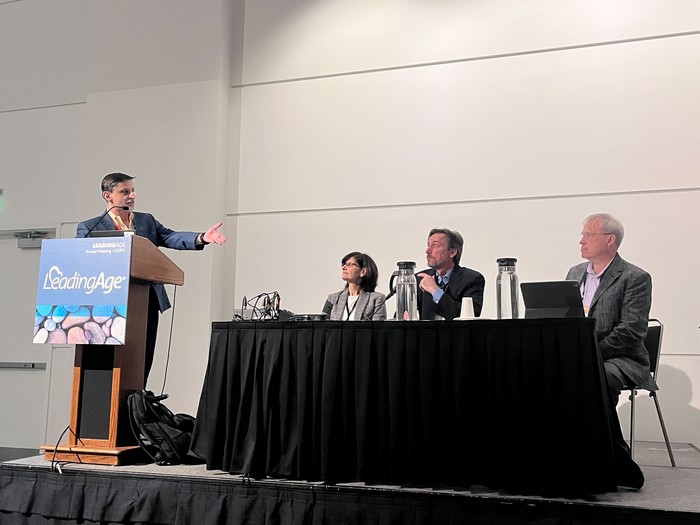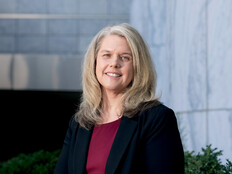Panelists at the LeadingAge Annual Meeting + EXPO discuss how senior care leaders can create successful digital transformation at their organizations. From left: Majd Alwan, Executive Director for the LeadingAge Center for Aging Services Technologies; Dusanka Delovska-Trajkova, CIO of Ingleside; Jim Michels, Vice President of Development and Strategic Operations at the Army Distaff Foundation and Knollwood; and Peter Kress, Senior Vice President and CIO at Acts Retirement-Life Communities.
Digital Transformation in Senior Care Starts With Culture Change
When Jim Michels, vice president of development and strategic operations at The Army Distaff Foundation and Knollwood, stepped into his role, he started by looking at the organization’s history of dealing with innovation.
“I looked and said, ‘Why not engage in aging innovation and health tech? There shouldn’t be a firewall between care and innovation.’ I needed to create that environment as a foundation for success,” he said.
Michels lobbied to review and rewrite part of Knollwood’s charters and gained buy-in from the board.
“If you don’t have the board on board, you’re going to have an uneven experience,” he said.
Creating partnerships with academic thought leaders was also helpful, according to Michels. He pointed out that it’s also a great way to develop future leaders for the organization’s board.
He emphasized the importance of involving residents in the journey.
“Engage residents and staff early and often to create a dynamic culture. Transformation shouldn’t be applied externally but should be embedded in the DNA of the organization,” said Michels.
Digital Transformation Offers a Way for Senior Care to Catch Up
“The way senior care has worked for the past 20 to 40 years is unlikely to allow us success over the next five to seven years,” said Peter Kress, senior vice president and CIO at Acts Retirement-Life Communities. “As we think about digital transformation, we have the opportunity to think about new ways to do business.”
Kress emphasized the importance of collaboration in digital transformation success. Letting a single department choose its own software will rarely transform an entire organization; it involves organizationwide intentional planning, according to Kress.
Looking at use cases from the past five years might not be as helpful as many senior care leaders think, he added.
“If your goal for transformation is to adopt what someone else did five years ago to make their system better, then you’ll only be as good as someone else was five years ago,” said Kress.
DISCOVER: Why senior care organizations need to prioritize health IT.
Kress highlighted the need for senior care organizations to engage with MACH architecture. This set of technology principles involves microservices, an API-first approach, cloud-native Software as a Service and “headless”technology.
“Small pieces don’t work unless they’re designed to be assembled,” he said. “Just like how interior design changes don’t require us to redo the whole building — that’s how we need to think about technology.”
When talking to vendors about their technology solutions, it’s important to understand how these solutions integrate and coexist.
Delovska-Trajkova encouraged senior care leaders to pressure vendors to delivery technology that exists in other sectors.
“Healthcare is 10 years behind, and senior care is 10 years behind healthcare, so we’re 20 years behind companies like Amazon,” she said. “Residents and staff are being trained by their experiences with apps like Grubhub and Uber. The tech exists, so why can’t we make it work in senior care?”
Keep this page bookmarked for our coverage of the 2022 LeadingAge Annual Meeting + EXPO, taking place Oct. 16-19 in Denver. Follow us on Twitter at @HealthTechMag and join the conversation at #LeadingAge22.














